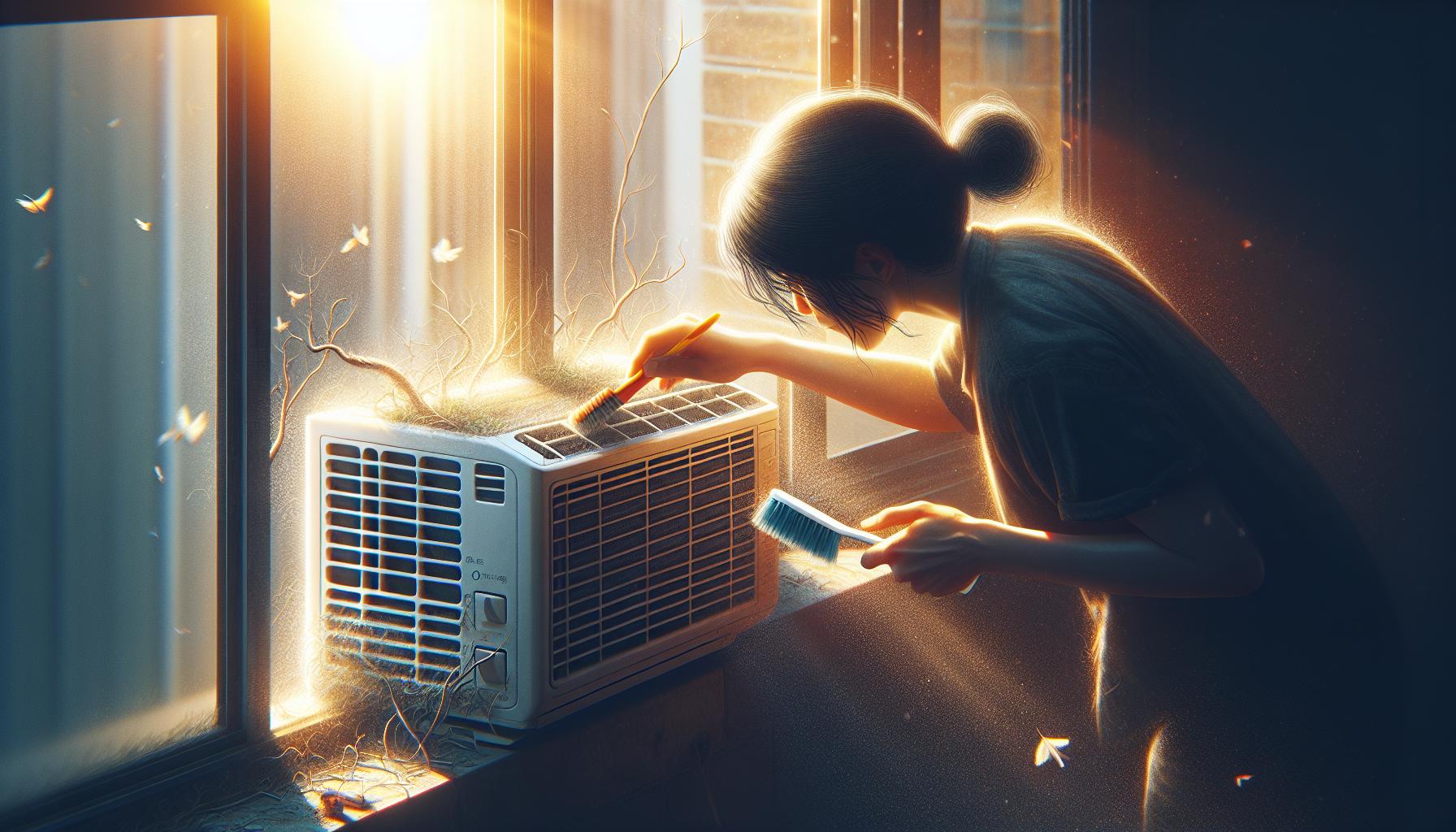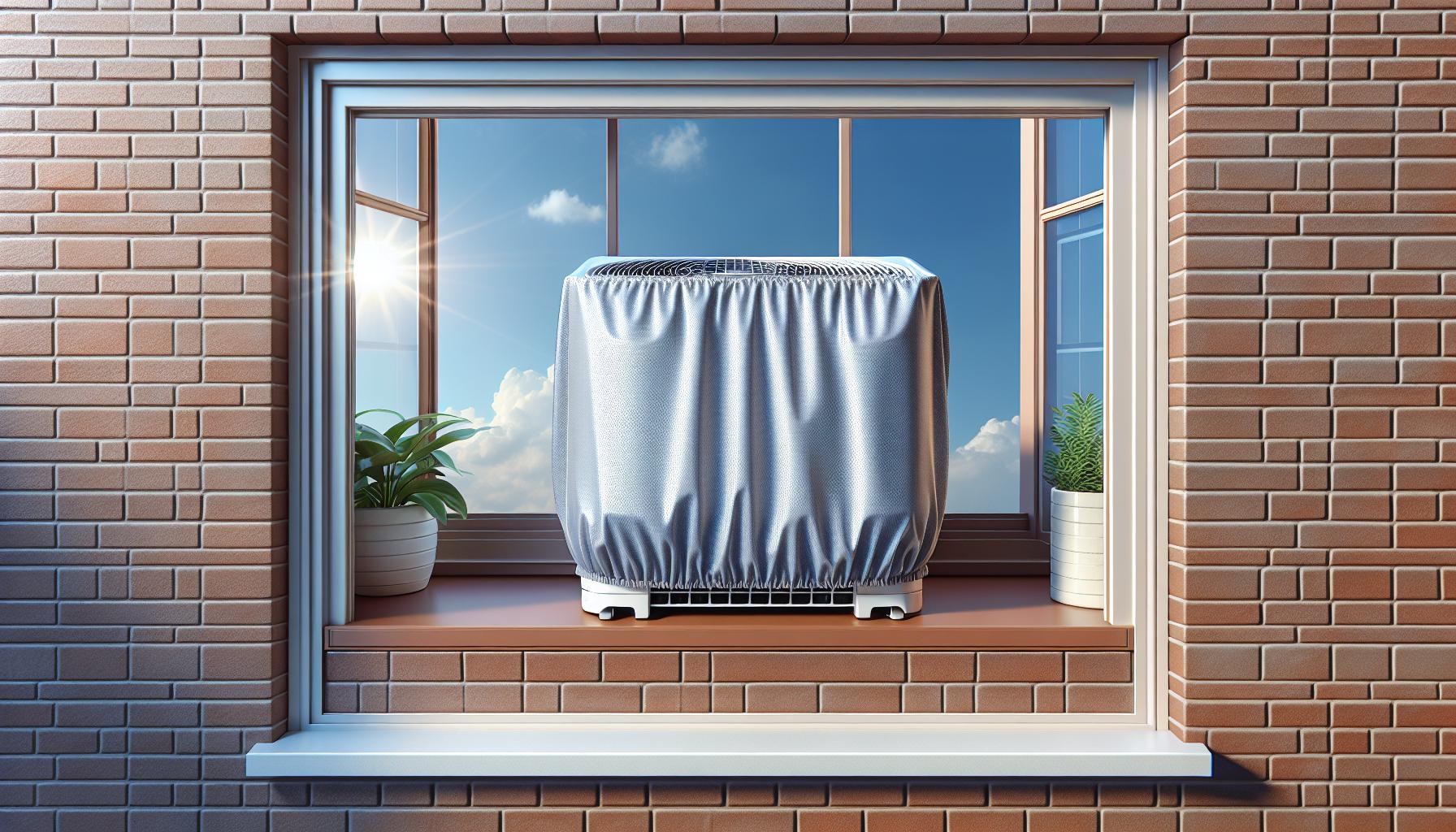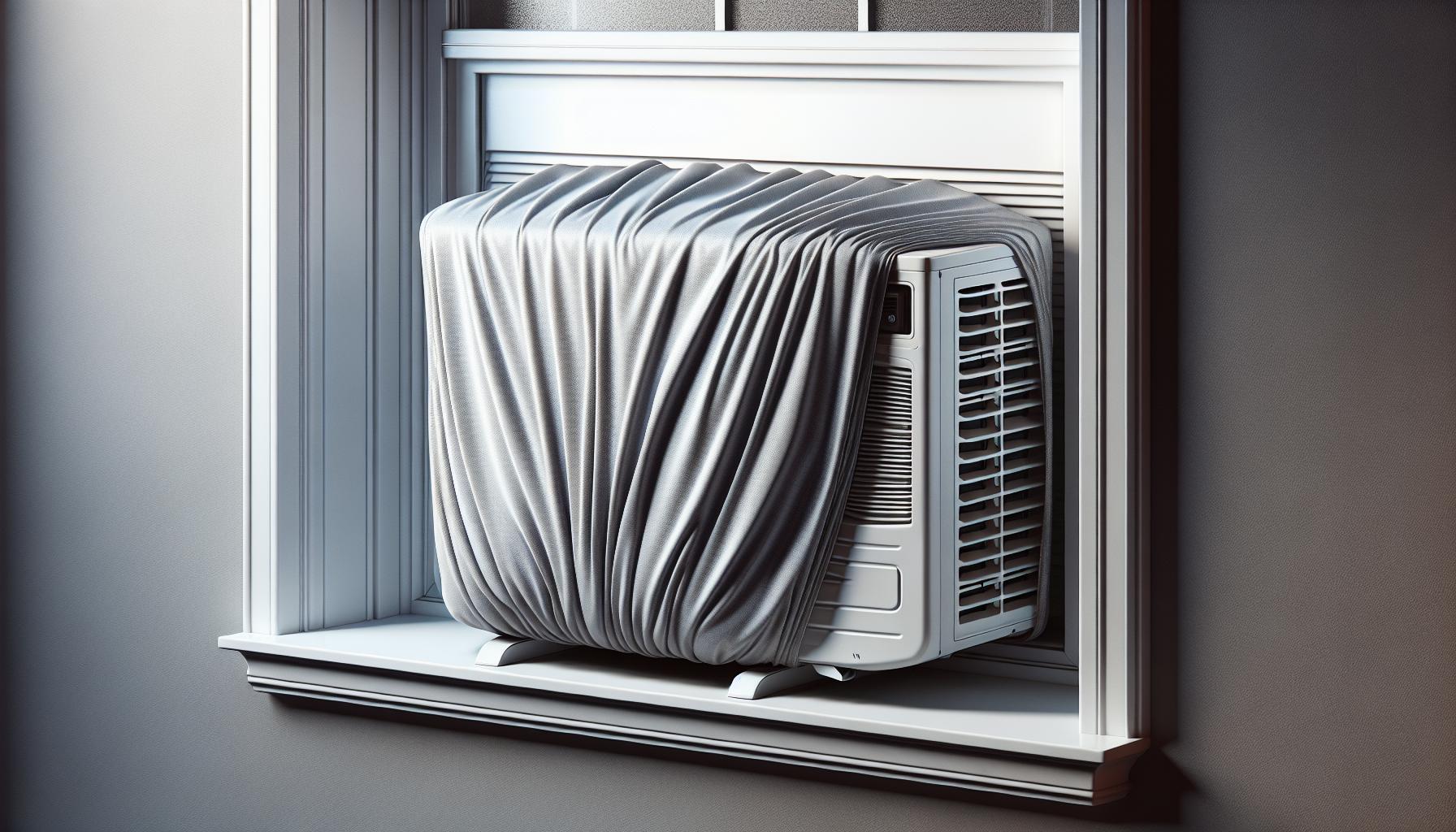As the seasons change, protecting your window-style air conditioner from dirt, debris, and harsh weather becomes crucial. A well-covered AC unit can prevent unwanted maintenance issues and prolong its lifespan. Whether you’re dealing with gusty winds or just preparing for the off-season, it’s important to know how to properly cover your air conditioner to keep it in top shape. With options ranging from the Outdoor Window AC Cover, rated 4.5 stars, to the heavy-duty, waterproof Air Conditioner Covers with adjustable straps, you’ve got plenty of choices to ensure your unit stays clean and protected. Let’s jump into the simple steps you can take to safeguard your window AC, keeping it ready for when you need it most.
Why Covering an Air Conditioner in a Window is Important
Protecting your window air conditioner isn’t just about extending its life; it’s about maintaining performance and efficiency. Here’s why a protective cover is essential:
- Protection Against Weather: Your window AC is vulnerable to harsh elements. Snow can melt and cause moisture buildup, leading to potential damage. Heavy storms and hail can also introduce small particles and gravel into the unit, compromising components and function.
- Avoiding Debris: Leaves, dirt, and other debris can clog and strain your AC, but a cover acts as a barrier, keeping the internals clean and reducing the frequency of maintenance.
- Maintaining Efficiency: Any obstruction in front of your AC’s indoor part limits airflow. An optimally-placed cover allows space for cool air delivery, ensuring efficient operation without overheating.
- Preserving Aesthetics: Beyond functionality, a cover with a stylish pattern can enhance the look of your window AC, integrating it well with your home’s exterior.
By incorporating a cover, particularly one that’s UV-treated and made from breathable material, you’re investing in the longevity and efficiency of your window air conditioner. Plus, pairing it with an external thermostat or smart AC controller can automate climate control, offering features like weekly scheduling and location-based controls.
Factors to Consider Before Covering your Air Conditioner

Weather Conditions
When it’s time to cover your window AC, you’ll need to consider the local weather conditions you face during off-seasons. Heavy snowfall and rain can wreak havoc on your unit, leading to corrosion and efficiency issues. A cover that’s designed to withstand harsh conditions is vital to extend the lifespan of your air conditioner. If your region is prone to wet weather, opt for a water-resistant cover that also allows breathability to prevent moisture build-up. In areas with intense sun exposure, a UV-treated cover can prevent the material from becoming brittle over time.
Type of Air Conditioner
The type of AC unit you have will largely influence the kind of cover you should choose. For standard window air conditioners that you use solely during the summer months, a full cover is appropriate to protect the entire unit. But, if you own a window heat pump that provides year-round service, covering it entirely isn’t advisable due to the need for continuous airflow and heat exchange. Instead, consider partial covering solutions that protect without restricting function.
Time of Year
The time of year you decide to cover your air conditioner is also crucial. As seasons change and temperatures drop, covering your window AC can safeguard it from the oncoming winter weather. But, wait until you’re sure you won’t need the AC again. Covering too early might tempt you to run the unit with the cover on, which could lead to overheating. Aim to cover your air conditioner when you’re certain that cooler weather is consistent and you can safely put the AC to rest until it’s needed again.
Preparing to Cover Your Air Conditioner

Cleaning the Air Conditioner
When getting ready to cover your air conditioner, it’s vital to clean the unit first. Begin by removing any dust, dirt or cobwebs with a soft brush or cloth from both the inside and exterior parts. Use a mild detergent and warm water mixture for tougher grime, ensuring all cleaning agents are thoroughly rinsed off to prevent corrosion or damage to the unit’s surfaces. After cleaning, allow the unit to dry completely to prevent trapping moisture, which could lead to mould growth or component damage.
Checking for Any Damage or Leaks
Inspect your air conditioner for signs of wear or damage before covering it. Look for cracks in the outer casing, damaged fins or tubes, and check for refrigerant leaks. It’s important to ensure all issues are fixed promptly, as existing problems can worsen over time when the unit is covered and out of sight. Leaks, in particular, can cause the coolant to escape and moisture to enter, resulting in reduced efficiency and the potential for internal corrosion.
Removing any Debris
Finally, remove all twigs, leaves, and debris that have gathered around the external unit. Debris can obstruct airflow and provide a haven for pests; so, it’s crucial to clear the area to maintain your unit’s performance and prevent damage. Properly securing the covering also means ensuring there s no loose material underneath the fabric that could rub against and harm the air conditioner’s surfaces during windy conditions.
Choosing the Right Cover for Your Air Conditioner

Material
When it comes to selecting the ideal material for your air conditioner cover, breathability is paramount. A breathable fabric ensures that while your unit is shielded from the elements, moisture does not get trapped inside, leading to potential mold and corrosion issues. Opt for covers crafted from polyester or nylon blends which are both durable and permeable. Also, UV-treated materials are invaluable as they resist sun damage, preserving the integrity and appearance of the cover over time. Remember, though protection is critical, the material must also allow air flow to inhibit any buildup of condensation.
Size and Measurement
Precise fitment is crucial when selecting an air conditioner cover. It’s vital to measure your window AC unit accurately before making a purchase. Here’s what you need to measure:
- Width: Measure side to side across the front of the AC unit.
- Depth: Measure from front to back of the AC unit.
- Height: Measure from the bottom to the top of the AC unit.
Ensure you add a couple of centimeters to each measurement for an optimal fit, allowing ease of installation and removal without being overly tight. The market offers a range of standard sizes, so match your dimensions to a cover that corresponds closely. If your window AC has an unconventional size, consider a custom-sized cover to get the perfect protection.
Design and Style
The aesthetic appeal of your air conditioner cover is also worth considering. While functionality remains the priority, you shouldn’t overlook the design aspect. Manufacturers today offer a variety of patterns and colours, allowing you to pick a cover that blends with or enhances your home’s exterior. Whether you desire a minimalist look or a vibrant pattern, there are styles to suit your preference. Besides, covers often come with functional design features, such as adjustable straps or drawstrings, which not only secure the cover in place during windy conditions but also add to the overall structure and appeal of the cover. Remember, the right cover will not only perform effectively by providing necessary protection but also complement the aesthetics of your outdoor space.
How to Cover Your Air Conditioner
 Maintaining your window air conditioner is crucial for its efficiency and longevity. Properly covering your unit when it’s not in use is a key step in this maintenance process. Below are clear instructions on how to correctly cover your air conditioner to protect it from the elements.
Maintaining your window air conditioner is crucial for its efficiency and longevity. Properly covering your unit when it’s not in use is a key step in this maintenance process. Below are clear instructions on how to correctly cover your air conditioner to protect it from the elements.
Step 1: Remove the Air Conditioner Front Cover
Firstly, you need to remove the front cover of your air conditioner. This is important for two reasons:
- Allows Cleaning: Removing the cover gives you the opportunity to clean the filters and interior, which can accumulate dust and debris over time.
- Prevents Damage: It ensures that no part of the cover gets caught up in the internal components, preventing potential damage.
Gently unclip or unscrew the cover, depending on your unit’s design. Store the cover in a safe place where it won’t get damaged.
Step 2: Place the Cover over the Air Conditioner
Once the front cover is off, and the interior is cleaned:
- Select the Right Cover: Choose a cover that’s designed specifically for window air conditioners. It should be made of breathable, waterproof material to prevent moisture build-up and be the correct size for your unit.
- Cover the Unit: Slide the cover over the unit carefully, making sure it fits snugly. This will protect your AC from dirt, debris, and off-season weather conditions such as snow and rain.
Choosing the right cover can prolong your AC’s lifespan and ensure it’s ready to use when the warmer weather returns.
Step 3: Secure the Cover in Place
Finally, you need to secure the cover:
- Adjustable Straps: If your cover comes with adjustable straps, tighten them to fit around your AC unit securely. This prevents the cover from blowing away in strong winds.
- L-Brackets for Support: For a more permanent solution, especially in areas with severe weather conditions, use L-brackets to attach the cover to the surrounding wall. Remember to leave adequate ventilation space and ensure the cover doesn’t hinder the unit’s airflow. This step is crucial for preventing overheating and allows for easy removal when it’s time for a routine inspection or maintenance check.
Protecting your window air conditioner with a cover is a simple yet effective way to extend its service life. By following these easy steps, you ensure your unit remains in tip-top condition, ready to keep your home comfortable no matter what the weather outside may be.
Maintaining the Covered Air Conditioner
Regular Cleaning and Maintenance
To keep your air conditioner functioning optimally, regular cleaning and maintenance are essential, even when it’s not in use. Dirt and debris tend to accumulate over time, which can affect the performance of your AC when summer rolls around. Here’s what you need to do:
- Check the Cover every few weeks to ensure it s intact and secured. Look out for rips or areas where it may have come loose.
- Clean the Cover when you spot dirt or algae to prevent any damage to the material. Use a mild soapy solution and rinse with a hose.
- Remove the cover periodically, following the manufacturer’s instructions, to check the unit underneath. This way, you: – Prevent mold and mildew buildup from trapped moisture. – Ensure that no pests have made their home inside.
- Dust or vacuum any visible parts of the AC, and wipe down surfaces gently with a damp cloth.
- Schedule professional tune-ups before peak usage periods to ensure your AC runs smoothly.
By incorporating these maintenance tasks into your routine, you safeguard your unit’s longevity and efficiency.
Checking for Any Issues
When monitoring your covered air conditioner, be on the lookout for potential issues that could lead to larger problems:
- Inspect the Unit for signs of rust or corrosion, which can indicate moisture problems.
- Listen for Unusual Noises when the AC is running, as these can be early warnings of mechanical issues.
- Check for Strange Smells when the unit is operational; a musty odor could suggest mold growth within the system.
If you encounter any of the above, it s advised to contact a professional to diagnose and rectify the issue immediately. Regular checks help prevent unexpected failures and maintain your AC’s performance. Remember, a well-kept air conditioner not only cools your space but also contributes to a healthier indoor environment. Keep your air conditioner covered and well-maintained, and it’ll serve you well for many summers to come.
Conclusion
Covering your air conditioner is a straightforward task that’ll safeguard your investment and enhance its performance. With the simple steps outlined, you’re now equipped to keep your unit in top condition throughout the year. Remember to stay vigilant for any signs of wear or damage to the cover and address them promptly. By taking these precautions, you’ll not only prolong the life of your air conditioner but also ensure it’s ready to keep you cool when the temperatures soar. It’s all about regular attention and care your AC will thank you for it.
